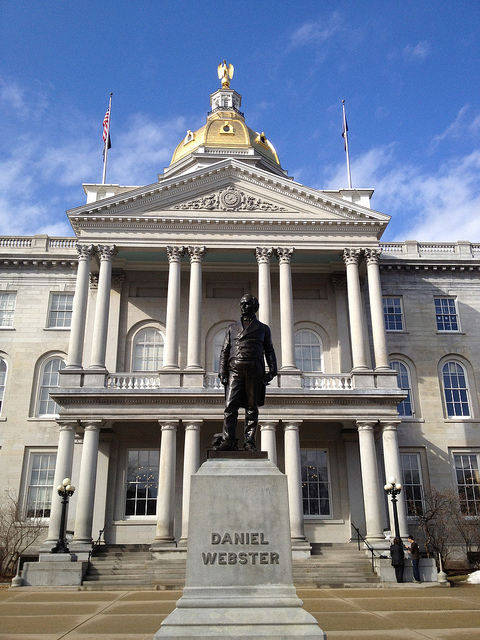Concord's (and New Hampshire's) State House is 200 years of awesome!
If you’re a local, you may already be aware that the New Hampshire State House is the oldest one in which the legislature still occupies its original chambers. We’re just old school like that. But did you also know that the State House is 200 +? That’s right, it’s that old. I like to think it’s in the true Yankee spirit of “if it ain’t broke, don’t fix it”. Other states have updated or built new buildings altogether, but not New Hampshire. I can’t help but be oddly proud of that old-fashioned traditionalism (and maybe even frugality). In the interest of the bicentennial and my own curiosity, I set out to find out some lesser known facts about this oldie but goodie of a State House.
The State House is a fascinating place to explore. Right as you enter, you’ll see more than 100 (107, to be exact) battle flags displayed, giving you a very clear idea of both the intensity of war and the troops’ dedication to carrying the flag throughout even the hardest fought battles. It’s awe-inspiring. When you wander the halls, you’ll notice portraits of former Governors and legislators of varying sizes… these were usually commissioned by the subject of the paintings, and I like to think the really big ones are the equivalent to having a flashy car in modern times. Just showing off their status and wealth for posterity, you know? The eagle that sits atop the State House dome (which can only be painted gold if you’ve had a President from your state – thanks Franklin Pierce!) is actually the second one to perch atop that gold dome. The first was created facing left, symbolizing war. It was replaced in 1957 with one facing right, symbolizing peace. The original is in the New Hampshire Historical Society building just up the street if you’d like to compare the two. The dome itself is lit all night, every night, like a lighthouse to direct you right to the heart of downtown Concord and the state itself. The only exception to this was when Governor Meldrim Thompson Jr ordered the lights to be turned off at night to save energy while he was in office from 1973-1979. Just days after his successor Hugh Gallen took over that was reversed, and the lights were turned back on. I’m glad, I love to see them shine from the highway when I’m coming home at night and I can even see them from my apartment. So Concord-y.
Did you know the State House has ties to what some refer to as the origins of camouflage? I know, *so* New Hampshire, right? Artist and New Hampshire native Abbott Thayer is sometimes credited as the father of camouflage. Taken from his Wikipedia page, “While he did not invent camouflage, he was one of the first to write about disruptive patterning to break up an object's outlines, about distractive markings, about masquerade, as when a butterfly mimics a leaf and especially about countershading.”His paintings can be found in many museums, including the Metropolitan Museum of Art and the Smithsonian. His cousin, Barry Faulkner, was also an artist, native New Hampshire resident, and camouflage expert. He, along with fellow artist Sherry Fry, organized the New York Camouflage Society at the start of WWI to help soldiers better understand how to disguise themselves in battle. He later went on to paint the four large murals you see in the Senate Chamber. One of those murals even depicts Abbott Thayer himself teaching an art class. While Teddy Roosevelt may have had reservations about these folks and their camouflage ideas (he was surprisingly rather outspokenly against Thayer’s ideas, which definitely affected Thayer’s life and career despite their adoption by many societies and military groups), their contributions to New Hampshire history won’t be forgotten thanks to the murals.
The archway in front of the State House was a much later addition. It wasn’t just a plain lawn before that though. As a result of the state’s centennial celebration in 1877, the State House lawn featured a rather controversial water fountain. Apparently, it was a whole thing. My favorite story I’ve heard about it when neighborhood kids threw a bunch of soap in it causing an overflow of bubbles all over the State House lawn and into the street sometime around 1880… which ended up becoming a recurring thing. And we say kids these days are troublemakers! The fountain was removed in 1914 and replaced with the statue of Franklin Pierce we’re all familiar with now. Is it too late to start a gofundme to get the fountain back? Not trying to start trouble here, but it seems like it was kinda fun. The archway you see now stands as a memorial to New Hampshire military personnel who died fighting for our country.
You’re always allowed to wander through the State House during their regular business hours, after all, it is “the people’s house” … but they also offer guided tours if you’re looking to get more of the history of the building and the legislative body that takes up office within.
Elyssa Alfieri is a freelance stylist, social media maven, vintage lover, and all-around Concord super fan. You can usually find her at her consignment shop, Lilise Designer Resale (or LDR), on Storrs St downtown. She also really wants you to know LDR is dog-friendly.

